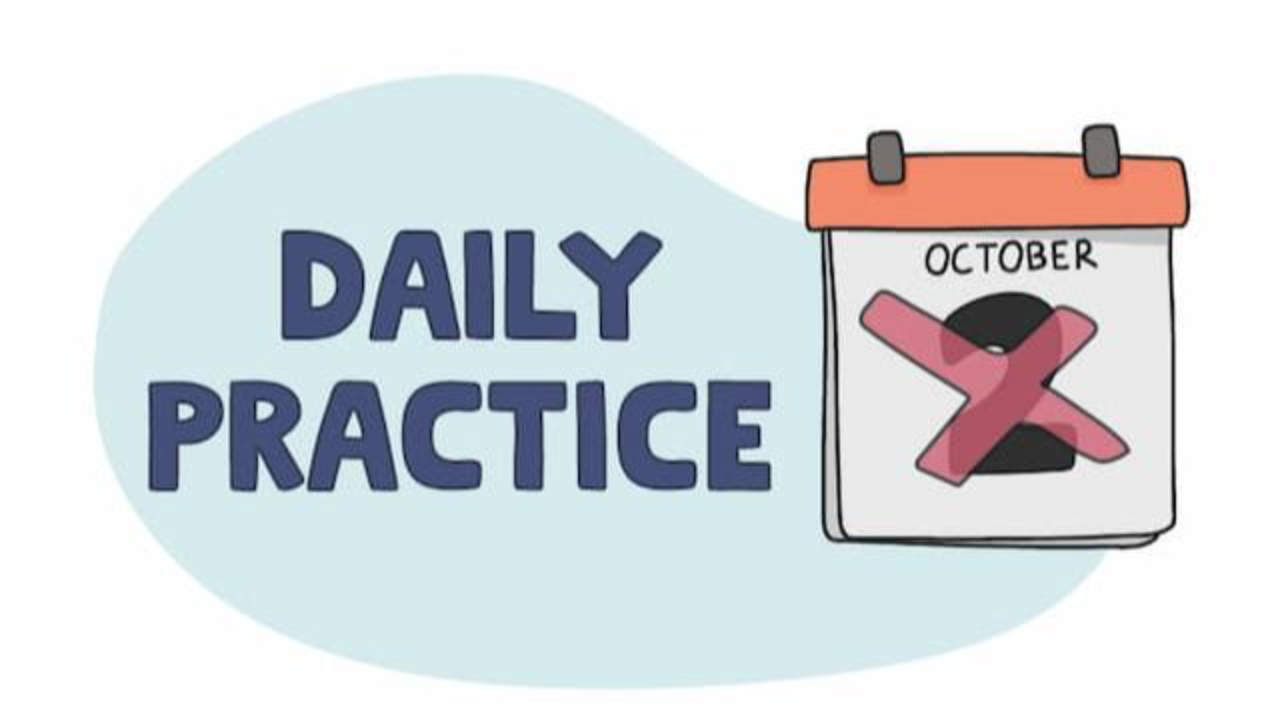The Best Ear Training Method You Can Use Every Day

Any musician worth their salt knows how important daily practice is. The only way to see consistent improvement is to do a little bit every day—this is far more effective than doing one monster practice session one day a week, or even two or three times a week.
When you practice every day, structural changes happen inside your brain, and physical changes happen to your body. The cognitive connections you make on day one are strengthened on day two, the connections you make on day two are strengthened on day three, and so on. Your muscles get stronger and more familiar with chord shapes and scales. If you play a string instrument, your calluses build up faster.
The same goes for your ear training practice. In order to improve, it’s crucial that you practice ear training every single day. Just 5 minutes once a day for a week will be far more effective than 30 minutes one day a week.
Unfortunately, it can be hard to know what to practice every day in order to train your ears. Practicing the wrong things (or even the right thing at the wrong time) will lead you astray and build up muscles and cognitive connections that don’t serve you in the long run or be detrimental to your goals. The same goes for ear training: there are highly effective and highly ineffective methods for ear training, and you must practice the right ones every day in order to improve.
What is Ear Training?
Before we dive into the nitty-gritty of how to train your ears with effective daily practice, let’s talk about what ear training is and why it is important.
Ear training is the process of understanding musical elements (chords, notes, scales, etc.) by ear alone and being able to imagine or recall them at will. All of this is related to our inner level of musicality. The more advanced our ear training skills, the more confident we are when playing music with other musicians or performing in front of an audience.
This is why musicians must strengthen their inner ear (which allows us to audiate–or hear music inside our head) until “speaking” the language of music becomes as natural as speaking their native language.
Training the inner ear usually involves a lot of listening, repeating, and singing. You don’t have to have a great voice to train your inner ear, but you should be able to produce notes on your own, without the aid of an instrument. Indeed, the ability to match pitch—or sing a note back when you hear it played—is one of the first steps of ear training.

Why Is Ear Training Important?
Training your ear builds a solid foundation for excelling in all musical pursuits. It is what allows you to seamlessly associate visual cues in music, such as patterns on a keyboard or fretboard or notations on a staff, to the corresponding musical sounds that you perceive or envision.
Read on for a more in-depth look at the benefits of ear training.

What Are The Benefits of Ear Training?
A strong inner ear improves nearly everything about your musical performance. From sight-reading and sight-singing to intonation, from recognizing notes and chords by ear to improvisation and songwriting, from writing music on the staff to freeing up your creativity and musical imagination.
Taking the time to train your ears every day (using the right methods) will make you more musically free and allow you to communicate more easily with other musicians in real-life situations like jams, choir practice, and band practice.
Lastly, you will feel more confident when playing or making music. You will finally be able to trust your musical ear and your instinct and go with your gut feelings.

What's the Best Ear Training Method Available?
There are four fundamental principles of ear training. These are the four pillars that will make your aural skills practice strong and highly effective. The best ear training methods (like the Use Your Ear courses) apply these four fundamentals to build a structured approach that covers all aspects of ear training.
Let’s take a look at what those principles are so we can better understand how to practice ear training in the most effective way.
Pyramidal Approach
Just like with going to the gym, your ear training practice must take a pyramidal approach. What does that mean? It means you must build foundational skills first, then move on to more advanced concepts one step at a time.
If you try to lift too much weight at the gym before you’re ready, you will fail, and may even hurt yourself. Similarly, if you jump into advanced ear training skills before you’re ready, you will fail, get frustrated, and quit. On the other hand, if you spin your wheels on easy concepts for too long, you will never make progress or improve.
For ear training, basic skills like pitch-matching, singing the scale, and internalizing the sonic sensations of scale degrees and chords, are foundational skills that must be solid before you can move on to more advanced things like recognizing complex jazz chord progressions for example.

Tonal Approach
The best ear training course must also take a tonal approach. By that, we mean that all the exercises you do must be grounded in tonality. It has been scientifically proven that the human brain perceives notes and chords as having a different sonic sensation depending on the tonality they are included in.
For this reason, you should always practice ear training exercises within the clear presence of a tonality. This might mean playing a major scale for yourself, or playing a I IV V progression before you begin. These are quick strategies to allow you to feel the tonic note as the gravitational center (the note that has the feeling of total resolution), which is essential in order for you to clearly perceive the specific sonic sensation of each scale degree.
You should not practice isolated intervals or use a trial-and-error approach. Isolated interval exercises never establish tonality and do not allow your brain to hear the full harmonic context of the music. Learning intervals in isolation will leave you confused when trying to reproduce or identify them in a real musical piece, which is (by definition) structured around a tonality.
Similarly, a trial-and-error approach won’t work well either. A trial-and-error approach involves picking out notes and chords at random on your instrument until you stumble upon the right combination that matches what you heard.
This will not build any long-term cognitive connections, and will make you dependent on your instrument in order to recognize the notes. You must learn to hear the notes and the harmonic context inside your head without relying on another instrument to produce them for you.

Developing Each Sub-Skill
Ear training skills are comprised of different sets of converging sub-skills. These sub-skills include things like short-term musical memory (the ability to retain a melodic line), tonic retention (remembering where the gravitational center of the tonality is), tonic recognition, note analysis and recognition, chord analysis and recognition, etc.
Most students are good at some sub-skills and not at others. For example, you might have great tonic retention but struggle with your short-term musical memory (indeed, short-term musical memory is a skill that is often neglected by many musicians). This sort of imbalance is the source of many issues in ear training. If not fixed properly, students can become stuck and start to believe there is something wrong with them—which is never the case in our experience.
A good ear training method will address all the necessary sub-skills for each ear training task and will help you to identify and work on the sub-skills that you are weakest at. For example, if your problem area is melodic dictation, it could be that you need to improve your short-term musical memory—or it could be that you have great short-term musical memory but struggle to analyze and recognize the notes. Depending on the specific issue that's hindering your progress, you should adapt your practice methods to effectively address it.
By isolating the specific sub-skills you need to work on, you will begin to make consistent progress in your ear training practice.

Use Real Music
The final thing that a good ear training method should do is teach you how to apply your skills to real-world musical situations. It is in those real-world situations that you will learn the most.
This could mean using real pieces of music to practice basic fundamental skills (practicing on real melodic lines and scales rather than isolated intervals, for example). It could also mean immediately applying what you’ve learned to analyzing the chords and notes of your favorite songs.
If you only ever practice exercises, you will only get better at the exercises. The exercises exist to strengthen your skills in a controlled and focused way—you must take those skills into the real world and apply them to real music in order to see growth and develop confidence in your skills.

Want to Learn More About the Use Your Ear Method?
If you’re ready to get serious about your aural skills training, we highly recommend checking out the Use Your Ear courses.
Our science-based, step-by-step ear training method has already helped thousands of musicians break through their old blocks and achieve greater levels of ear training success they couldn’t even imagine possible for themselves.
In our Relative Pitch Video Course you will be guided through a path tailored to your specific needs, and designed to be effective no matter your current level. Even if you’ve failed with other ear training methods in the past, with our guidance, you'll be amazed at how much you can improve within just a few months of daily practice.
We’ve already helped thousands of musicians and music students improve their ear training skills with our scientifically-proven aural skills practice method. Most of them were amazed by the results—especially after coming from other ear training methods that didn’t work for them.
You don’t have to take our word for it: check their improvements yourself.
Not sure you want to commit to a course yet? No problem! Sign up for our Free Ear Training Workshop to dip your toes into our methods and learn what we’re all about. You'll get exclusive exercises to practice on your own, and you’ll gain a deeper understanding of the concepts behind our approach.
The workshop includes lots of practical exercises, ear training tips, and clear explanations of the most important scientific findings related to the human perception of musical pitch. You’ll walk away knowing exactly how to practice ear training according to your current level (and also…what not to practice!)
We also offer 1-on-1 Lessons for anyone who prefers to get instant feedback from an experienced private tutor, qualified in teaching the Use Your Ear method. Receive tailored support from a teacher who can help you identify your problem areas, provide you with the best training materials for your situation, and guide you through an effective ear training practice.
Conclusion
It’s never too late to start your strongest daily practice ever. Get in touch today and start improving your ear training skills right now!

